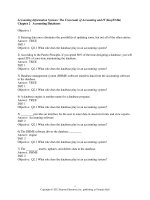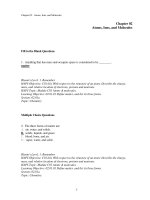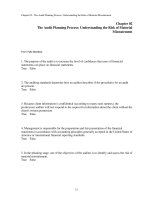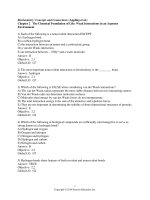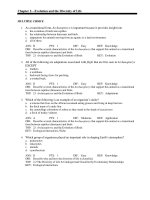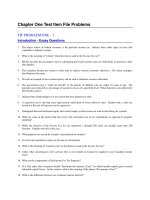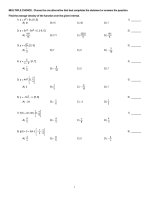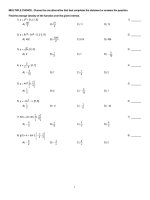Drugs behaviour and society 1st edition hart test bank
Bạn đang xem bản rút gọn của tài liệu. Xem và tải ngay bản đầy đủ của tài liệu tại đây (115.9 KB, 12 trang )
02
Student: ___________________________________________________________________________
1.
The Canadian government, in the early 1900s had virtually no laws regulating the sale and use of drugs.
In general the government took a "hands-off" approach that has been referred to as
A. criminal.
B. laissez-faire.
C. toxic.
D. irresponsible.
2.
The text lists three concerns that led to the adoption of the first laws regulating what we now call
controlled substances. Which of these was NOT one of the three?
A. high profits for drug sellers
B. toxicity
C. dependence
D. association of drug users with crime
3.
When the use of a substance makes normal activities such as driving result in harmful accidents, it is
called
A. behavioural tolerance.
B. drug misuse.
C. behavioural toxicity.
D. laissez-faire.
4.
Acute drug effects are those that
A. are dangerous.
B. are caused by the immediate presence of the drug in the body.
C. are unrelated to dose.
D. last more than a day.
5.
Which is an example of chronic physiological toxicity?
A. lung cancer from smoking
B. amotivational syndrome
C. paranoia from methamphetamine use
D. respiratory arrest from an alcohol overdose
6.
The Drug Abuse Warning Network
A. is a system of free public-service announcements.
B. is a voluntary organization for teachers and police officers.
C. monitors drug-related medical emergencies.
D. monitors arrest rates for various drug-law violations.
7.
Which of these substances has consistently been near the top of both the emergency room visits and drugrelated deaths lists for many years?
A. alcohol-in-combination
B. marijuana
C. methamphetamine
D. ecstasy (MDMA)
8.
In 2007, ______________ was the most common type of drug mentioned in the DAWN mortality
reports.
A. GHB
B. opioids (not heroin)
C. marijuana
D. methamphetamine
9.
In comparing the relative toxicity of marijuana and cocaine, it is important to take into account
A. the user's gender.
B. availability and price.
C. urban vs. rural environment.
D. that many more people use marijuana than use cocaine.
10. DAWN data provides all of the following EXCEPT
A. Information about which drugs are associated with the greatest number of deaths.
B. Clear measures of the toxicity of individual drugs.
C. Data regarding problems associated with alcohol-in-combination.
D. General information about trends in drug-related deaths.
11. Intravenous drug users have higher than average rates of HIV infection, but even higher rates of
A. hepatitis C.
B. herpes simplex.
C. staphylococcus infection.
D. ADHD.
12. When repeated exposure to the same dose of a drug results in a lesser effect, this is called
A. acute toxicity.
B. dependence.
C. vaccination.
D. tolerance.
13. The occurrence of a withdrawal syndrome is evidence of
A. physical dependence.
B. chronic behavioral disorder.
C. an antigen-antibody reaction.
D. craving.
14. The drugs, to which people are most likely to develop psychological (behavioural) dependence, are
generally also found to have
A. stimulant effects.
B. pain-relieving effects.
C. sedative effects.
D. reinforcing effects in laboratory animals.
15. The DSM-IV-TR does not define addiction as such, but has diagnostic criteria for
A. habituation.
B. substance dependence and substance abuse.
C. chronic intoxication.
D. drug-associated bipolar disorder.
16. As views of substance dependence have changed based on scientific research, the real driving force
behind repeated excessive drug use is now believed to be
A. psychological dependence, based on reinforcement.
B. physical dependence, caused by tolerance.
C. an allergic reaction to the substance.
D. unmet psychological needs in early childhood.
17. Which of these substances is listed as having a "very high" dependence potential?
A. LSD
B. marijuana
C. alcohol
D. crack cocaine
18. Brain scan studies with drug users
A. can show which people have developed dependence and which have not.
B. can predict which people will later develop dependence.
C. so far can only show changes in response to drug administration.
D. are very strong predictors of alcohol use, but not for other substances.
19. Those who have received a "personality disorder" diagnosis, such as antisocial personality disorder,
A. have an increased likelihood of also having a substance use disorder.
B. are neither more nor less likely to have a substance use disorder.
C. are actually less likely to be dependent on a substance.
D. are often given stimulant drugs as a treatment for the personality disorder.
20. The most important reason for the adoption of a disease model of dependence has been
A. the success of medical treatments for dependence.
B the desire to study and treat dependence as a problem in its own right, rather than as a symptom of
. some other "underlying" disorder.
C. the value of blood and urine tests in diagnosing the severity of dependence.
D. the desire of physicians to treat alcohol and other drug dependence.
21. In determining whether using a drug causes people to become criminals, it is important to remember
that
A. there is no statistical relationship between crime and illicit drug use.
B. most illicit drugs cause damage to the areas of the brain responsible for understanding right from
wrong.
C. longitudinal studies find that indicators of criminal or antisocial behaviour usually occur before the first
use of any illicit drug.
D. consistent personality changes are likely with even a few exposures to heroin or cocaine.
22. Which of the following drugs is most accepted as contributing to crimes and violence?
A. alcohol
B. heroin
C. marijuana
D. cocaine
23. In an annual study done by the U.S. Justice Department, people arrested for various crimes are given
urine tests to detect the presence of drugs. In 2003, about ________ percent of the adult male arrestees
tested positive for at least one illicit drug.
A. 90
B. 67
C. 40
D. 25
24. At the present time, approximately of federal inmates in Canada are incarcerated as a result of drug
offences.
A. 1/5
B. 1/2
C. 1/8
D. 3/4
25. The term "laissez-faire" refers to the tendency of news media to sensationalize drug problems.
True False
26. Very early in the 20th century the Canadian government regulated, and made a profit from, the production
of opium.
True False
27. Chronic drug effects refer to those that are due to prolonged exposure to the drug.
True False
28. The DAWN system tells us exactly how many deaths are caused by a specific drug each year.
True False
29. In 2005, methamphetamine was the leading drug associated with emergency-room visits.
True False
30. Our best estimate is that tobacco cigarettes were associated with over 37,000 deaths in Canada in
2002.
True False
31. Physical dependence is defined by the appearance of withdrawal symptoms when the drug is stopped.
True False
32. The drugs that are most likely to lead to dependence are the ones that have reduced effects after repeated
use.
True False
33. Longitudinal studies find that indicators of criminal or antisocial behavior usually occur earlier in life
than the first use of an illicit drug.
True False
34. The commission of crimes by drug users is due in large part to a pharmacological affect of the drug itself
that causes the user to believe he/she is invincible.
True False
35. Needle exchange programs began in Canada in 1989, however the programs were found to have little
impact on the rate of HIV infection among intravenous drug users and were too expensive an initiative to
continue.
True False
36. Discuss the relative toxicity dangers of alcohol and cocaine, as revealed by the DAWN system.
37. Describe the implications of the Positive Reinforcement Model in explaining repeated drug use.
38. Explain what is meant by a drug's "dependence potential."
39. Describe several ways in which people have thought that drug use might be a cause of criminal
behavior.
40. Explain the difference between physical dependence on a drug and psychological dependence on a
drug.
02 Key
1.
(p. 24)
The Canadian government, in the early 1900s had virtually no laws regulating the sale and use of
drugs. In general the government took a "hands-off" approach that has been referred to as
A. criminal.
B. laissez-faire.
C. toxic.
D. irresponsible.
BT: Remember
Hart - Chapter 02 #1
2.
(p. 24-25)
The text lists three concerns that led to the adoption of the first laws regulating what we now call
controlled substances. Which of these was NOT one of the three?
A. high profits for drug sellers
B. toxicity
C. dependence
D. association of drug users with crime
BT: Remember
Hart - Chapter 02 #2
3.
(p. 25)
When the use of a substance makes normal activities such as driving result in harmful accidents, it is
called
A. behavioural tolerance.
B. drug misuse.
C. behavioural toxicity.
D. laissez-faire.
BT: Remember
Hart - Chapter 02 #3
4.
(p. 25-26)
Acute drug effects are those that
A. are dangerous.
B. are caused by the immediate presence of the drug in the body.
C. are unrelated to dose.
D. last more than a day.
BT: Understand
Hart - Chapter 02 #4
5.
(p. 25-26)
Which is an example of chronic physiological toxicity?
A. lung cancer from smoking
B. amotivational syndrome
C. paranoia from methamphetamine use
D. respiratory arrest from an alcohol overdose
BT: Understand
Hart - Chapter 02 #5
6.
(p. 26-27)
The Drug Abuse Warning Network
A. is a system of free public-service announcements.
B. is a voluntary organization for teachers and police officers.
C. monitors drug-related medical emergencies.
D. monitors arrest rates for various drug-law violations.
BT: Remember
Hart - Chapter 02 #6
7.
(p. 27)
Which of these substances has consistently been near the top of both the emergency room visits and
drug-related deaths lists for many years?
A. alcohol-in-combination
B. marijuana
C. methamphetamine
D. ecstasy (MDMA)
BT: Remember
Hart - Chapter 02 #7
8.
(p. 27)
In 2007, ______________ was the most common type of drug mentioned in the DAWN mortality
reports.
A. GHB
B. opioids (not heroin)
C. marijuana
D. methamphetamine
BT: Remember
Hart - Chapter 02 #8
9.
(p. 29)
In comparing the relative toxicity of marijuana and cocaine, it is important to take into account
A. the user's gender.
B. availability and price.
C. urban vs. rural environment.
D. that many more people use marijuana than use cocaine.
BT: Remember
Hart - Chapter 02 #9
10.
(p. 29)
DAWN data provides all of the following EXCEPT
A. Information about which drugs are associated with the greatest number of deaths.
B. Clear measures of the toxicity of individual drugs.
C. Data regarding problems associated with alcohol-in-combination.
D. General information about trends in drug-related deaths.
BT: Understand
Hart - Chapter 02 #10
11.
(p. 30)
Intravenous drug users have higher than average rates of HIV infection, but even higher rates of
A. hepatitis C.
B. herpes simplex.
C. staphylococcus infection.
D. ADHD.
BT: Remember
Hart - Chapter 02 #11
12.
(p. 32)
When repeated exposure to the same dose of a drug results in a lesser effect, this is called
A. acute toxicity.
B. dependence.
C. vaccination.
D. tolerance.
BT: Remember
Hart - Chapter 02 #12
13.
(p. 32)
The occurrence of a withdrawal syndrome is evidence of
A. physical dependence.
B. chronic behavioral disorder.
C. an antigen-antibody reaction.
D. craving.
BT: Remember
Hart - Chapter 02 #13
14.
(p. 33)
The drugs, to which people are most likely to develop psychological (behavioural) dependence, are
generally also found to have
A. stimulant effects.
B. pain-relieving effects.
C. sedative effects.
D. reinforcing effects in laboratory animals.
BT: Understand
Hart - Chapter 02 #14
15.
(p. 34)
The DSM-IV-TR does not define addiction as such, but has diagnostic criteria for
A. habituation.
B. substance dependence and substance abuse.
C. chronic intoxication.
D. drug-associated bipolar disorder.
BT: Understand
Hart - Chapter 02 #15
16.
(p. 34-35)
As views of substance dependence have changed based on scientific research, the real driving force
behind repeated excessive drug use is now believed to be
A. psychological dependence, based on reinforcement.
B. physical dependence, caused by tolerance.
C. an allergic reaction to the substance.
D. unmet psychological needs in early childhood.
BT: Understand
Hart - Chapter 02 #16
17.
(p. 37)
Which of these substances is listed as having a "very high" dependence potential?
A. LSD
B. marijuana
C. alcohol
D. crack cocaine
BT: Remember
Hart - Chapter 02 #17
18.
(p. 36-37)
Brain scan studies with drug users
A. can show which people have developed dependence and which have not.
B. can predict which people will later develop dependence.
C. so far can only show changes in response to drug administration.
D. are very strong predictors of alcohol use, but not for other substances.
BT: Understand
Hart - Chapter 02 #18
19.
(p. 37)
Those who have received a "personality disorder" diagnosis, such as antisocial personality
disorder,
A. have an increased likelihood of also having a substance use disorder.
B. are neither more nor less likely to have a substance use disorder.
C. are actually less likely to be dependent on a substance.
D. are often given stimulant drugs as a treatment for the personality disorder.
BT: Remember
Hart - Chapter 02 #19
20.
(p. 38)
The most important reason for the adoption of a disease model of dependence has been
A. the success of medical treatments for dependence.
B. the desire to study and treat dependence as a problem in its own right, rather than as a symptom of
some other "underlying" disorder.
C. the value of blood and urine tests in diagnosing the severity of dependence.
D. the desire of physicians to treat alcohol and other drug dependence.
BT: Remember
Hart - Chapter 02 #20
21.
(p. 39)
In determining whether using a drug causes people to become criminals, it is important to remember
that
A. there is no statistical relationship between crime and illicit drug use.
B. most illicit drugs cause damage to the areas of the brain responsible for understanding right from
wrong.
C. longitudinal studies find that indicators of criminal or antisocial behaviour usually occur before the
first use of any illicit drug.
D. consistent personality changes are likely with even a few exposures to heroin or cocaine.
BT: Remember
Hart - Chapter 02 #21
22.
(p. 39)
Which of the following drugs is most accepted as contributing to crimes and violence?
A. alcohol
B. heroin
C. marijuana
D. cocaine
BT: Remember
Hart - Chapter 02 #22
23.
(p. 40)
In an annual study done by the U.S. Justice Department, people arrested for various crimes are given
urine tests to detect the presence of drugs. In 2003, about ________ percent of the adult male arrestees
tested positive for at least one illicit drug.
A. 90
B. 67
C. 40
D. 25
BT: Remember
Hart - Chapter 02 #23
24.
(p. 40)
At the present time, approximately of federal inmates in Canada are incarcerated as a result of drug
offences.
A. 1/5
B. 1/2
C. 1/8
D. 3/4
BT: Remember
Hart - Chapter 02 #24
25.
(p. 25-26)
The term "laissez-faire" refers to the tendency of news media to sensationalize drug problems.
FALSE
BT: Understand
Hart - Chapter 02 #25
26.
(p. 24)
Very early in the 20th century the Canadian government regulated, and made a profit from, the
production of opium.
TRUE
BT: Understand
Hart - Chapter 02 #26
27.
(p. 25-26)
Chronic drug effects refer to those that are due to prolonged exposure to the drug.
TRUE
BT: Remember
Hart - Chapter 02 #27
28.
(p. 26-27)
The DAWN system tells us exactly how many deaths are caused by a specific drug each year.
FALSE
BT: Understand
Hart - Chapter 02 #28
29.
(p. 27)
In 2005, methamphetamine was the leading drug associated with emergency-room visits.
FALSE
BT: Understand
Hart - Chapter 02 #29
30.
(p. 28-29)
Our best estimate is that tobacco cigarettes were associated with over 37,000 deaths in Canada in
2002.
TRUE
BT: Remember
Hart - Chapter 02 #30
31.
(p. 32)
Physical dependence is defined by the appearance of withdrawal symptoms when the drug is
stopped.
TRUE
BT: Remember
Hart - Chapter 02 #31
32.
(p. 33)
The drugs that are most likely to lead to dependence are the ones that have reduced effects after
repeated use.
FALSE
BT: Understand
Hart - Chapter 02 #32
33.
(p. 38-39)
Longitudinal studies find that indicators of criminal or antisocial behavior usually occur earlier in life
than the first use of an illicit drug.
TRUE
BT: Remember
Hart - Chapter 02 #33
34.
(p. 40)
The commission of crimes by drug users is due in large part to a pharmacological affect of the drug
itself that causes the user to believe he/she is invincible.
FALSE
BT: Remember
Hart - Chapter 02 #34
35.
(p. 31)
Needle exchange programs began in Canada in 1989, however the programs were found to have little
impact on the rate of HIV infection among intravenous drug users and were too expensive an initiative
to continue.
FALSE
BT: Remember
Hart - Chapter 02 #35
36.
Discuss the relative toxicity dangers of alcohol and cocaine, as revealed by the DAWN system.
(p. 25-29)
Alcohol-in-combination and cocaine have been associated with similar numbers of emergency room
visits and drug-related deaths over the years. Since many more people use alcohol than use cocaine,
one could conclude that cocaine is relatively more dangerous (per user) than alcohol. However,
it is also important to note that DAWN does not report on alcohol when it is used alone, only in
combination with other substances. Bonus: cocaine's toxicity is also influenced by how it is used.
BT: Evaluate
Hart - Chapter 02 #36
37.
Describe the implications of the Positive Reinforcement Model in explaining repeated drug use.
(p. 34-35)
Efforts to treat drug dependence by focusing on reducing or eliminating physical dependence
(withdrawal) will have limited usefulness. Treatments also need to break the positive associations that
have developed to people, objects, or situations that have been linked to drug use in the past.
BT: Evaluate
Hart - Chapter 02 #37
38.
Explain what is meant by a drug's "dependence potential."
(p. 33-37)
Some drugs are more likely than others to lead to compulsive use. These tend to be the drugs that
work as positive reinforcers in animal models. Bonus: However, blaming dependence entirely on the
drug itself ignores many other important social and individual variables.
BT: Evaluate
Hart - Chapter 02 #38
39.
(p. 38-40)
Describe several ways in which people have thought that drug use might be a cause of criminal
behavior.
Drug use might change the individual's personality in a lasting way, making him or her into a criminal
type (evidence does not support this). Drug use might cause criminal behavior while the person is
under the influence of the drug (evidence strongest for alcohol). Crimes may be carried out for the
purpose of obtaining money to purchase illicit drugs (evidence supports this).
BT: Evaluate
Hart - Chapter 02 #39
40.
(p. 32-35)
Explain the difference between physical dependence on a drug and psychological dependence on a
drug.
In physical dependence, when a person stops taking the drug a set of physiological symptoms will
appear as the drug level in the system drops. Symptoms disappear when the drug is taken again. In
psychological dependence, when a person takes a drug (behavioural act), they receive a consequence
such as a good feeling, or they escape from pain or discomfort. When the drug is stopped, often the
user will crave the drug. The behaviour is being reinforced by the consequence.
BT: Evaluate
Hart - Chapter 02 #40
02 Summary
Category
# of Questions
BT: Evaluate
5
BT: Remember
23
BT: Understand
12
Hart - Chapter 02
40
